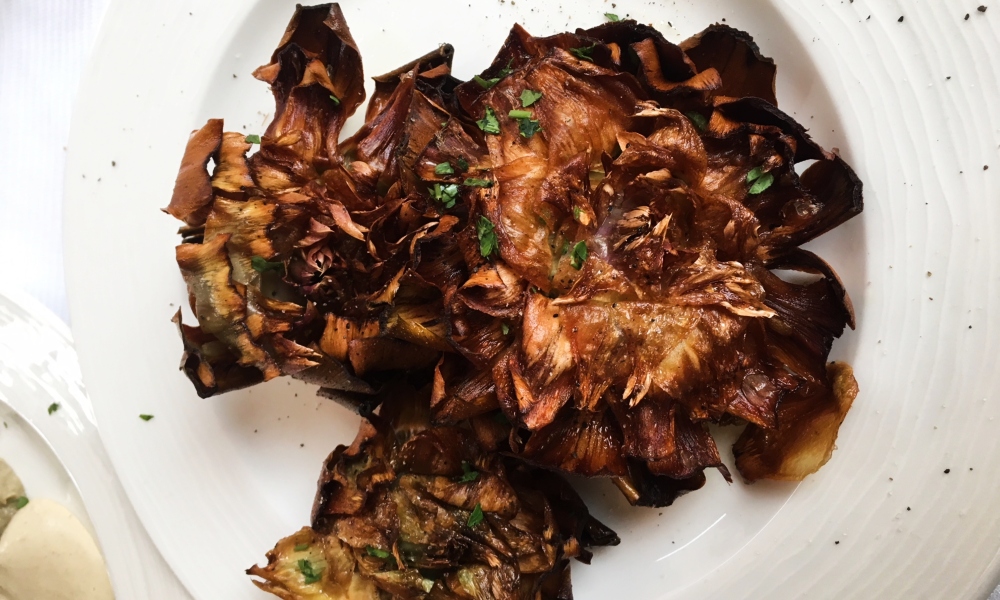In Rome several months ago, the future of the signature dish of the city’s 2,000-year-old Jewish community—the carciofo alla giudia (Jewish-style artichoke)—was threatened by a decree from the Israeli rabbinate’s head of imports, Yitzhak Arazi, who declared the speciality treif (non-kosher). The reason, he argued, was that worms and parasites could get into the heart of the artichoke, thereby posing a risk that someone might inadvertently consume such a bug. Rome was in uproar at the prospect of the artichoke’s demise—and understandably so. Tourists as well as locals from Rome’s Jewish community have long flocked to Il Ghetto in the historic heart of Rome, where this delicacy has been served since the 16th century.
The famed recipe is to take a “Roman” artichoke (smaller than the usual vegetable), slice off the outer leaves with a sharp knife, open it up by beating it, soak it in water with lemon juice and sprinkle with salt and pepper. Then deep fry it in olive oil, remove and drop some cold water to make it crisp and then serve it hot.

A sign outside BellaCarne restaurant, next door to Ba’Ghetto. (Dina Gold)
Little reported was the fact that the Israeli rabbinate’s remit is to set kashrut policies in Israel, and that the edict extended only as far as those products imported to Israel from overseas. Jewish communities around the world are, in fact, able to set their own kashrut policies. Still, some Italian Jewish restaurants did (temporarily) obey the edict, and disappointed customers found their beloved carciofo alla giudia were unavailable.
The media soon piled in with lurid headlines such as “Rome’s Jews Fume After Israeli Rabbinate Bans Staple Dish,” “Rome’s Jews Condemned for Traditional Artichoke Dish” and “Has Rome Declared an Artichoke War?” There were numerous stories of protests, petitions and interviews with religious leaders and restaurant owners. A popular meme on social media among Rome’s Jews was “Je suis carciofo”—a play on “Je suis Charlie,” the slogan that spread across the world following 2015 terror attack on the Paris offices of the satirical magazine Charlie Hebdo.
Experts pointed out that, unlike the artichokes common in Israel, the type used in Italy—mammole, Romanesco or cimaroli—have tightly overlapping leaves which insects are unable to penetrate.
Jews have lived in Rome since 161 BCE, making this the oldest Jewish community in Western Europe. The ghetto, a crowded area where the Jews were forced to live, was founded under a papal decree in 1555 by Pope Paul IV. It was a seven-acre, once-walled and now well-protected area close to the Tiber River that frequently flooded. In 1870 Jews no longer were forced to live in the ghetto, and in 1888 most of the ghetto walls were demolished. Jews were forced to live there again by the Germans during the World War II.

Dining at Ba’Ghetto. (Dina Gold)
After a visit to the Great Synagogue and Jewish Museum of Rome, it took just a few minutes’ stroll to reach the heart of the ghetto. Walking down Via Della Reginella, and stopping to read the numerous Stolpersteine (stumbling stones) laid into the cobbled sidewalk outside the last homes of Jews deported during the Third Reich, you see ahead of you several kosher restaurants, including the oldest in Rome, Ba’Ghetto.
There’s no mistaking what’s on offer—it’s all kosher, and a big sign at the entrance announces “The Best Jewish Style Artichoke and other Roman Jewish Specialties.” Not a hint of the much-trumpeted treif tirade.

A sign outside Ba’Ghetto. (Dina Gold)
Ordering a carciofo alla giudia was a must. What was the real story, we inquired, and had the furor died down? Our waiter, an Israeli immigrant, explained that one shipment to Israel from Italy had been left unchecked for longer than normal, and that when an inspector had finally sliced open one particular artichoke, he had found a worm. And although the rumpus that ensued had been excessive, it had now blown over entirely. Our fried artichokes duly arrived and were, I can reliably report, absolutely delicious—with a nutty flavor and crispy texture. At nearby tables, plenty of other diners were also enjoying this iconic delicacy. Rest assured, there is no longer an “artichoke war” in Italy. Enjoy!


This absurdity coming from the Israeli rabbinate belongs in the medieval from whence it sprung. As artichokes go, so does lettuce – who knows what might crawl into a head of lettuce? Is even celery or cabbage or even Brussel spouts exempt from this rabbinical foolishness?
My understanding is that the edict applied to already prepared Carciofi alla Giudia being imported into Israel. If this is the case then of course it is not kosher, as it’s also not edible. Carciofi alla Giudia, like a good potato latke, needs to go from the pan to the mouth with absolute minimal delay. To pre-prepare such dish and then ship it over 1000 km is pure sacrilege, and the Rabbis were correct in banning it, if only to preserve its good character.